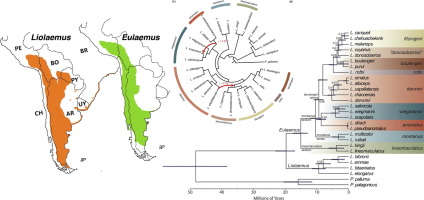当前位置:
X-MOL 学术
›
Mol. Phylogenet. Evol.
›
论文详情
Our official English website, www.x-mol.net, welcomes your
feedback! (Note: you will need to create a separate account there.)
Phylogenomic data resolve higher-level relationships within South American Liolaemus lizards.
Molecular Phylogenetics and Evolution ( IF 3.6 ) Pub Date : 2020-03-05 , DOI: 10.1016/j.ympev.2020.106781 Mariana Morando 1 , Melisa Olave 2 , Luciano J Avila 3 , Jack W Sites 4 , Adam D Leaché 5
Molecular Phylogenetics and Evolution ( IF 3.6 ) Pub Date : 2020-03-05 , DOI: 10.1016/j.ympev.2020.106781 Mariana Morando 1 , Melisa Olave 2 , Luciano J Avila 3 , Jack W Sites 4 , Adam D Leaché 5
Affiliation

|
Phylogenomic approaches now generate hundreds of loci representative of the whole genome that can be used for phylogenetic analyses. The South American lizard genus Liolaemus is the most species-rich vertebrate radiation from temperate zones (more than 265 described species), yet most higher-level phylogenetic relationships within Liolaemus remain poorly resolved. In this study, we used 584 nuclear loci collected using targeted sequenced capture to estimate the phylogenetic relationships among 26 species representing the two subgenera within Liolaemus (Eulaemus + Liolaemus), and all major groups within Eulaemus. Previous molecular and morphological-based phylogenetic analyses of Eulaemus based on a limited number of characters resolved few higher-level relationships, although one point of agreement is that the early divergence within Eulaemus corresponds to the lineomaculatus section, followed by the diversification of eight main clades that are strongly supported and recognized. Liolaemus probably experienced relatively rapid divergences during parts of its evolutionary history, and a phylogenomic approach was used to resolve the relationships among the major groups. The new analyses presented here support the division of Liolaemus into two subgenera, and resolve relationships among many of the major clades of Eulaemus with strong support. A Bayesian divergence dating analysis using 44 protein-coding genes provides an estimation of the split of the two Liolaemus subgenera of approximately 19,7 ma (95% HPD = 16,94-23,04), while diversification within Eulaemus started at 15,05 ma (95% HPD = 12,94 - 17,59) among the L. lineomaculatus and the L. montanus series by Mid Miocene. A novel phylogenetic network analyses for SNP data identified two hybridizing edges among different groups of Eulaemus at different points in time. Having a solid phylogenetic hypothesis of the main Eulaemus clades opens new opportunities to test a variety of macroevolutionary questions for this unique radiation.
中文翻译:

植物统计学数据解析了南美蜥蜴蜥蜴中的更高层次的关系。
系统发育学方法现在产生了代表整个基因组的数百个基因座,可用于系统发育分析。南美蜥蜴属Liolaemus是温带地区物种分布最丰富的脊椎动物辐射(超过265种已描述物种),但Liolaemus内最高级的系统发育关系仍然难以解决。在这项研究中,我们使用了有针对性的序列捕获收集的584个核基因座,以评估代表Liolaemus内两个亚属(Eulaemus + Liolaemus)的26种物种以及Eulaemus内所有主要群体的系统发生关系。先前基于有限数量的字符对E的分子和形态学进行的系统发育分析,解析出的高层关系很少,尽管达成共识的一点是,在Eulaemus内的早期分歧对应于lineomaculatus区域,然后是八个受到支持和认可的主要进化枝的多样化。Liolaemus可能在其进化历史的某些部分中经历了相对迅速的分歧,并且采用了一种植物学方法来解决主要群体之间的关系。此处提出的新分析支持将Liolaemus分为两个亚属,并在强有力的支持下解决了Eulaemus许多主要进化枝之间的关系。使用44种蛋白质编码基因进行的贝叶斯发散定年分析提供了两个Liolaemus亚属的分裂的估计值,大约为19,7 ma(95%HPD = 16,94-23,04),而Eulaemus内的多样化始于15年。 05个月(95%HPD = 12,94-17,59)中新世中期的L. lineomaculatus和L. montanus系列。对SNP数据进行的新型系统进化网络分析在不同的时间点确定了不同种群的ula属之间的两个杂交边缘。对主要的Eulaemus进化枝有明确的系统发育假说,为针对这种独特的辐射测试各种宏观进化问题提供了新的机会。
更新日期:2020-03-05
中文翻译:

植物统计学数据解析了南美蜥蜴蜥蜴中的更高层次的关系。
系统发育学方法现在产生了代表整个基因组的数百个基因座,可用于系统发育分析。南美蜥蜴属Liolaemus是温带地区物种分布最丰富的脊椎动物辐射(超过265种已描述物种),但Liolaemus内最高级的系统发育关系仍然难以解决。在这项研究中,我们使用了有针对性的序列捕获收集的584个核基因座,以评估代表Liolaemus内两个亚属(Eulaemus + Liolaemus)的26种物种以及Eulaemus内所有主要群体的系统发生关系。先前基于有限数量的字符对E的分子和形态学进行的系统发育分析,解析出的高层关系很少,尽管达成共识的一点是,在Eulaemus内的早期分歧对应于lineomaculatus区域,然后是八个受到支持和认可的主要进化枝的多样化。Liolaemus可能在其进化历史的某些部分中经历了相对迅速的分歧,并且采用了一种植物学方法来解决主要群体之间的关系。此处提出的新分析支持将Liolaemus分为两个亚属,并在强有力的支持下解决了Eulaemus许多主要进化枝之间的关系。使用44种蛋白质编码基因进行的贝叶斯发散定年分析提供了两个Liolaemus亚属的分裂的估计值,大约为19,7 ma(95%HPD = 16,94-23,04),而Eulaemus内的多样化始于15年。 05个月(95%HPD = 12,94-17,59)中新世中期的L. lineomaculatus和L. montanus系列。对SNP数据进行的新型系统进化网络分析在不同的时间点确定了不同种群的ula属之间的两个杂交边缘。对主要的Eulaemus进化枝有明确的系统发育假说,为针对这种独特的辐射测试各种宏观进化问题提供了新的机会。











































 京公网安备 11010802027423号
京公网安备 11010802027423号